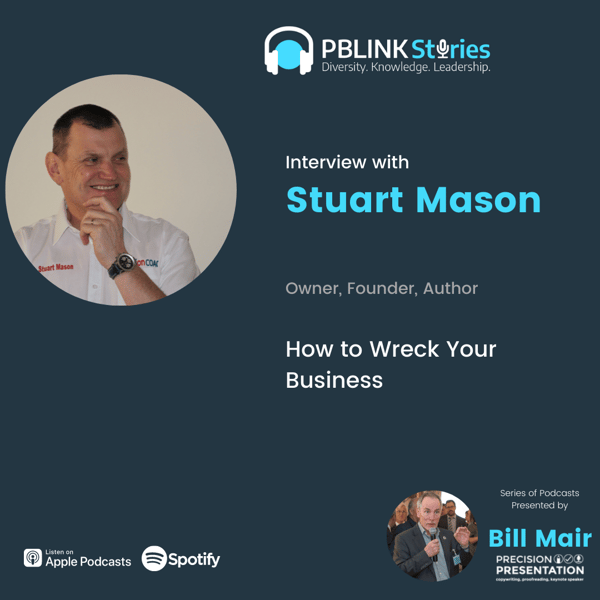Stuart Mason had it all and more: he was a millionaire with fiercely loyal, dedicated, professional, happy staff. The business was booming, Stuart travelled his business empire in his helicopter or his hand-built Aston Martin. At one point he had a property portfolio worth £1.4 million and £500K in the bank.
Then, one day, it all went wrong. The business crashed and the administrators were called in. Stuart lost everything.
What did he do right? What did he do wrong?
Nowadays, he works as an Action Coach, advising businesses on how to avoid the mistakes he made. Stuart has been there, done it and knows what he’s talking about. If he is giving you business advice, it is not abstract theory – it’s from lived experience!
Stuart has written a book about his story: How to Wreck Your Business. It covers when he left school with no qualifications and started his business, the helicopter chase, an arson attack, the hand-built Aston Martins, the dodgy bank people, the eventual collapse of the business and the lessons to be learned from it all. This blog post gives just a little flavour of that story.
Leadership
Let’s start the story at the end.
When the administrators were called in to shut down Stuart’s national chain of print shops, his employees refused to stop work on outstanding print jobs. The Print Shop had made commitments to their customers and the staff were determined to honour them.
In fact, after 20 years of trading, many of the staff had been with Stuart since the beginning.
That shows good leadership - a trait and a skill that Stuart refers to in his book.

Growth
In between setting up his first print shop in 1993, in the famous Glasgow Barras covered street market and the administrators coming in, Stuart built up a chain of 8 print centres across Scotland over a period of 20 years. When asked how he achieved such growth, he replies “Luck!”
But, while it was true that he had no formal business training and no real business forecasts or plans, except in his head, there was more to his success than blind luck.
Stuart looked at the weaknesses of the print industry and exploited them. He disrupted the market. Unlike the High Street print shops of the day, the Ink Shop was open 8 am – 8 pm, 7 days a week. Their timetable meant they caught the retail customers at the weekend and evenings and B2B during the week. At the weekend they would tidy up and transform from a business print centre to retail, with a big offering of wedding stationery.
They established a reputation for value-for-money, timely, reliable service and they expanded as word of mouth spread.
Plans and Systems
But, as Stuart says, flying by the seat of your pants only gets you so far. He now preaches the value of plans and systems, and outlines the value of a five-year vision planner, with dreams broken down into achievable goals along the way.
He uses the analogy of a leaky bucket. If you continuously pour water into a bucket, you get your feet wet. It’s only when the flow of water slows that you realise the bucket was never overflowing: it was leaking. So it is with finance, customers and cash flow. It’s easy to be complacent during the fat years but this is when you should be checking every aspect of your business coach, seeing where the opportunities are being missed, money is being wasted.
Fix the bucket and keep your feet dry, even when there is torrent of cash and customers.
Knowledge
Stuart cannot stress enough the value of knowing your metrics. “You can only improve what you accurately measure” is a mantra he repeats and explains frequently. If you have a number of marketing initiatives running and sales are going up, great. But how much is each campaign costing you? Can you identify which campaigns are generating customers? Are some of them actually losing you money? Is your marketing a cost or an investment?
Stuart talks of four conversion rates which can help:
- Marketing Reach to Initial Enquiry
- Initial Enquiry to Qualified Lead
- Qualified Lead to Quote
- Quote to Sale
For example, you can track the reach of your social media (eg LinkedIn) articles posts and adverts easily. Then look at how many Initial Enquiries they generate. Now, you start drilling down to research how many of those enquiries progress to a Qualified Lead. From this point, you’re investigating your own customer service and sales performance. How many leads result in a quote and how many eventual sales. If your percentage of sales from quotes is low, you need to consider pricing. If you are generating high initial enquiries but low sales, you need to find where the weak link is in the process and fix it.
Accurate measurement brings deep knowledge of your own marketing and of your customers, making your marketing an investment, not a cost. Learn before you earn.
Read about Secret of success this business coach here
Stuart was interviewed by Bill Mair of PrecisionPresentation.com for PBLINK Stories.
Listen to the podcast on Spotify or Apple: PBLINK Stories




Submit a Comment